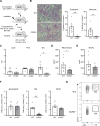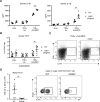CSF2-dependent monocyte education in the pathogenesis of ANCA-induced glomerulonephritis
- PMID: 35418479
- PMCID: PMC9279749
- DOI: 10.1136/annrheumdis-2021-221984
CSF2-dependent monocyte education in the pathogenesis of ANCA-induced glomerulonephritis
Abstract
Objectives: Myeloid cell activation by antineutrophil cytoplasmic antibody (ANCA) is pivotal for necrotising vasculitis, including necrotising crescentic glomerulonephritis (NCGN). In contrast to neutrophils, the contribution of classical monocyte (CM) and non-classical monocyte (NCM) remains poorly defined. We tested the hypothesis that CMs contribute to antineutrophil cytoplasmic antibody-associated vasculitis (AAV) and that colony-stimulating factor-2 (CSF2, granulocyte-macrophage colony-stimulating factor (GM-CSF)) is an important monocyte-directed disease modifier.
Methods: Myeloperoxidase (MPO)-immunised MPO-/- mice were transplanted with haematopoietic cells from wild-type (WT) mice, C-C chemokine receptor 2 (CCR2)-/- mice to abrogate CM, or transcription factor CCAAT-enhancer-binding protein beta (C/EBPβ)-/- mice to reduce NCM, respectively. Monocytes were stimulated with CSF2, and CSF2 receptor subunit beta (CSF2rb)-deficient mice were used. Urinary monocytes and CSF2 were quantified and kidney Csf2 expression was analysed. CSF2-blocking antibody was used in the nephrotoxic nephritis (NTN) model.
Results: Compared with WT mice, CCR2-/- chimeric mice showed reduced circulating CM and were protected from NCGN. C/EBPβ-/- chimeric mice lacked NCM but developed NCGN similar to WT chimeric mice. Kidney and urinary CSF2 were upregulated in AAV mice. CSF2 increased the ability of ANCA-stimulated monocytes to generate interleukin-1β and to promote TH17 effector cell polarisation. CSF2rb-/- chimeric mice harboured reduced numbers of kidney TH17 cells and were protected from NCGN. CSF2 neutralisation reduced renal damage in the NTN model. Finally, patients with active AAV displayed increased urinary CM numbers, CSF2 levels and expression of GM-CSF in infiltrating renal cells.
Conclusions: CMs but not NCMs are important for inducing kidney damage in AAV. CSF2 is a crucial pathological factor by modulating monocyte proinflammatory functions and thereby TH17 cell polarisation.
Keywords: Autoantibodies; Autoimmune Diseases; Granulomatosis with polyangiitis; Inflammation; Systemic vasculitis.
© Author(s) (or their employer(s)) 2022. Re-use permitted under CC BY-NC. No commercial re-use. See rights and permissions. Published by BMJ.
Conflict of interest statement
Competing interests: None declared.
Figures







References
Publication types
MeSH terms
Substances
LinkOut - more resources
Full Text Sources
Research Materials
Miscellaneous

